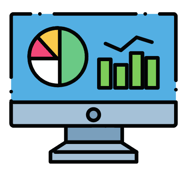
Building a great marketing campaign relies on more than increased engagement and conversions alone. You also need to take it a step further and interpret your conversion rates and return on investment (ROI) for each element of your various campaigns. Basic analytics provides some of those answers since PPC, or Pay Per Click, campaigns and keyword dashboards often show your conversion rate and any upticks.
Measuring beyond the surface-level impressions gives a much more in-depth view of your marketing campaigns. Follow these best practices to use multiple metrics to successfully measure your marketing ROI.
What Should I Look for in Marketing ROI?
At a basic level, measuring your marketing ROI tells you which elements of your strategy work at an acceptable level for their cost. For example, some PPC ad keywords are more expensive than others. If a $5 keyword gives you the same click-through rate and revenue per customer conversion as a $1 keyword, then the $1 keyword is bringing you a better return on investment.
Focusing on advertising ROI alongside marketing success analyzes opportunity as well as activity. Rather than reflecting on marketing costs and determining their value relative to successful sales once a quarter, marketers can measure their ROI in real-time.
You can receive live updates if your keywords go up in price or if you have a sudden burst of traffic. You can measure your social media ads’ click-through rate in real-time to test different times and formats.
Marketing ROI Is More Than Meets The Eye
Follow these five strategic practices to sense the broader picture of your marketing beyond costs and revenue alone.
1. Measuring Engagement Fills in the ROI Gaps
 Customer experience is more important than ever because customers have more say than ever. The internet gives consumers more capabilities to research and compare brands than ever before. You need to understand how customers interact with your business to adequately determine the future of your marketing campaigns. Set up your reports or dashboards to measure engagement, not just sales. Key indicators of engagement are:
Customer experience is more important than ever because customers have more say than ever. The internet gives consumers more capabilities to research and compare brands than ever before. You need to understand how customers interact with your business to adequately determine the future of your marketing campaigns. Set up your reports or dashboards to measure engagement, not just sales. Key indicators of engagement are:
- Liking or sharing social media posts
- Viewing ads and videos for their full runtime
- Subscribing to your channel or newsletter
- Navigating across your site through internal links
- Putting products in a shopping cart (even if they temporarily abandon it)
Measure these levels of engagement so you can grade and nurture leads. You can also use this data to refine your online presence and invest more time or money in the most engaging content.
2. Rely on Multiple Touchpoints to Track Success
Leads generally won’t become customers immediately. Allowing for seven or eight touchpoints with each lead increases the chances of a successful sale. More is better, but the advantage of additional touchpoints decreases with every new one. For example, the fifteenth touchpoint’s benefit is much smaller than the seventh one. Every industry has an optimal number of touchpoints where prospects are primed to purchase before your touchpoints stop being effective. Determine when leads are close to that purchase point to give them a final push into purchasing from you, and learning the best number for your unique business will help you guarantee your campaign’s success.
As you learn your visitors' engagement patterns, you can even incorporate the data into your lead scoring process. Intermittent touchpoints over a long period may indicate a long-term follower despite their never making a purchase. They may spread familiarity with your brand through word-of-mouth, making them valuable to your efforts. Leads who engage with your platforms frequently over a short period (especially with touchpoints involving high-value products and services) may warrant a call. On the other hand, leads engaging with the same content frequently may be completely cold despite their high engagement level.
3. Tracking Your Content Performance Is Essential
 Content marketing is an essential element in any long-term marketing strategy, but it's also incredibly time-intensive. Knowing how your audience engages with your content ensures your efforts are cost-effective. Adjusting your campaigns or implementing digital targeting helps your ads get noticed and reach the right audiences.
Content marketing is an essential element in any long-term marketing strategy, but it's also incredibly time-intensive. Knowing how your audience engages with your content ensures your efforts are cost-effective. Adjusting your campaigns or implementing digital targeting helps your ads get noticed and reach the right audiences.
Continuously measure your content engagement to know which pieces resonate and what types of content you should focus on.
Different techniques for measuring marketing ROI on your content include:
- Measuring click-through rates of in-depth content or landing pages
- Contact form completion
- Heat maps that model reading and engagement with the content (as opposed to scrolling or idling)
- Duration of visits
4. Measure Risks Avoided as Much as Returns
It's easy to see what boosts your ROI, but it's harder to see what doesn't sink your ROI. Avoiding obstacles and costly campaigns with a low rate of return should be part of your analysis whenever possible. Measure factors such as the performance of keywords with different CPC ad costs and A/B test your landing pages and ads. Having this information on hand can highlight how essential analytics is to inform your strategies, letting you form a rough estimate of costs avoided over time.
While it may seem counterintuitive, tracking mistakes and corrections is just as important as monitoring big wins.
5. Don't Neglect Tracking Sales
 Engagement, lead conversions and upselling all work toward sales, and sales are the foundation of your ROI measurement. You need to know how many sales — and how much revenue — marketing costs incur. If you get $500 of revenue per $80 of marketing spend, that's a high ROI. If return customers spend that same $500 per $30 of targeted marketing spend, that's not just good news; that tells you where to spend your time and effort.
Engagement, lead conversions and upselling all work toward sales, and sales are the foundation of your ROI measurement. You need to know how many sales — and how much revenue — marketing costs incur. If you get $500 of revenue per $80 of marketing spend, that's a high ROI. If return customers spend that same $500 per $30 of targeted marketing spend, that's not just good news; that tells you where to spend your time and effort.
The True Measure of Your Marketing ROI Is Relationships
Ultimately, your ROI analysis should focus on the relationships built through your marketing efforts. While sales are significant, you can't go from cold leads to loyal customers with no steps in between. Following these marketing ROI secrets helps you gauge how successful your in-between efforts are and invest accordingly moving forward.





